
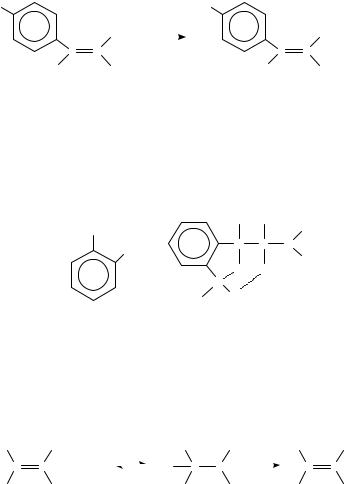
8. Complex formation involving double-bonded functional groups |
397 |
|||||
Me2 N |
|
Me2 N |
|
|
|
|
|
CN |
+ A rNH2 |
|
CN |
+ |
ArNH3 + F − |
|
|
|
||||
C |
C |
|
C |
C |
|
|
F |
CN |
|
ArNH |
CN |
|
|
|
(76) |
|
|
(77) |
|
|
|
|
SCHEME 35 |
|
|
|
|
When ArNH2 is o-phenylenediamine (80), the reaction is poorly catalysed by the second amino group, but it is mainly catalysed by an external molecule of amine. As a consequence, internal catalysis by an intramolecular complex such as 81 is unlikely. In competition with the substitution (Scheme 34), when the nucleophile (or a base) attacks a hydrogen atom in a ˇ position with respect to the leaving group, an elimination reaction takes place.
NH2 |
|
H |
Ar |
CN |
|
|
− |
||
|
N |
|
||
|
NH2 |
C C |
|
|
|
+ |
|
CN |
|
|
|
|
||
|
|
H |
F |
|
|
|
|
||
|
|
N |
|
|
|
|
H |
|
|
(80) |
|
(81) |
|
|
Investigations158 of the stereochemistry of vinylic substitutions on nitroolefins revealed that the lifetime of the carbanion (73) of Scheme 34 is sufficiently long to enable rotation around the CDC bond faster than the leaving-group departure156.
The reactions of ˇ-methoxy-˛-nitrostilbene (82) with anionic sulphurated nucleophiles159 showed UV/VIS spectroscopic evidence for the presence of the intermediate 83 in the formation of the substitution product (84) illustrated in Scheme 36.
Ph |
|
NO2 |
|
Ph |
NO2 |
|
Ph |
NO2 |
|
|
+ RS− |
|
|
− |
|
C C |
+ MeO − |
C |
C |
|
RS |
C C |
|
|||
|
|
|||||||
|
||||||||
MeO |
|
Ph |
|
MeO |
Ph |
|
RS |
Ph |
|
(82) |
|
|
|
(83) |
(84) |
|
|
R = C2 H5; HOCH2 CH2 ; MeO2 CCH2 CH2 ; MeO2 CCH2
SCHEME 36
Piperidine and morpholine react160 with benzylideneacetylacetone 85 to form a mixture of zwitterionic and anionic adducts (86 and 87, respectively) which forms benzaldehyde, acetylacetone and starting amine, as shown in Scheme 37. This has been confirmed by kinetic investigations in DMSO/water (50%).
The formations of 86 and 87 parallel the formation of zwitterionic complexes in reactions of amines with nitro-activated aromatic substrates161.
The substituted benzylidenemalonodialdehydes (89) are organic Lewis acids and they react with feeble nucleophiles (ethanol, water) affording162 the equilibrium mixture of

398 |
|
|
|
|
|
|
|
|
|
Luciano Forlani |
|
|
|
|
||
Ph |
COCH |
|
|
|
|
|
|
|
|
Ph |
COCH3 |
|||||
|
3 |
|
|
|
|
|
|
|
|
|
|
|
|
|||
C C |
|
|
|
|
+ R1R2 NH |
|
|
H C C − |
||||||||
|
||||||||||||||||
|
|
|||||||||||||||
H |
COCH3 |
|
|
|
|
|
|
|
R1R2 NH |
COCH3 |
||||||
|
|
|
|
|
|
|
|
|
|
|
|
|
+ |
|
||
(85) |
|
|
|
|
|
|
|
|
|
|
|
|
(86) |
|
||
|
|
|
|
|
|
|
|
|
|
|
|
|
|
|
−H + |
|
|
|
|
|
|
|
|
|
|
|
|
|
|
|
|
|
|
|
|
|
Ph |
|
COCH3 |
|
|
|
|
|||||||
|
|
|
|
|
Ph |
COCH3 |
||||||||||
|
|
|
|
|
|
|
|
|
|
|
|
|
|
|
|
|
|
|
|
|
|
|
|
|
|
|
|
|
C − |
||||
|
H |
|
C |
|
|
C |
|
H |
H C |
|||||||
|
|
|
|
|
||||||||||||
|
|
|
|
|
|
|
|
|
|
|
COCH3 |
|||||
|
R1R2 N |
COCH3 |
R1R2 N |
|||||||||||||
|
|
|
|
|
|
(88) |
|
|
|
|
|
|
(87) |
|||
|
|
|
COCH3 |
|
|
|
|
|
|
|
|
|
|
|
||
|
|
|
HC |
− |
+ |
|
|
|
+ 1 2 |
|
|
|
PhCHO |
|
|
|
|
|
|
|
|
|
|
|
|
||||||||
|
|
|
|
|
|
|
||||||||||
|
|
|
COCH3 |
|
PhCH |
|
NR R |
|
|
+ (CH3 CO)2 CH2 |
||||||
|
|
|
|
|
|
|
|
|
|
|
||||||
|
|
|
|
|
|
|
|
|
|
|
|
|
|
+ R1R2 NH |
|
|
|
R1R2 NH = piperidine, morpholine |
|
|
|
|
|
|
|
|
|
||||||
|
|
|
|
|
|
|
|
SCHEME 37 |
|
|
|
|
|
|||
|
H |
|
|
|
|
|
|
H |
|
|
|
|
H |
|
|
|
Ar |
C |
O |
|
|
|
Ar |
|
C |
O |
|
|
Ar |
C |
− |
||
|
|
|
|
|
|
|
|
O |
||||||||
C |
C |
|
+ ROH |
|
H |
|
C C |
H |
|
|
|
H C C |
|
+ H+ |
||
|
|
|
|
|
|
|
||||||||||
|
|
|
|
|
|
|
|
|||||||||
H |
C |
O |
|
|
|
RO |
|
C |
O |
|
|
RO |
C |
O |
||
|
|
|
|
|
|
|
|
|
|
|
|
|
|
|
||
|
H |
|
|
|
|
|
|
H |
|
|
|
|
H |
|
|
|
|
(89) |
|
|
|
|
|
|
(90) |
|
|
(91) |
|
|
|||
R = H, Et. |
|
|
|
|
|
|
|
|
|
|
|
|
|
|
|
|
|
|
|
|
|
|
|
|
SCHEME 38 |
|
|
|
|
|
|||

8. Complex formation involving double-bonded functional groups |
|
399 |
|||||||||
R |
|
|
|
|
R |
|
|
|
|
R |
|
C |
O |
|
Ph |
C |
O |
|
|
Ph |
C |
O |
|
|
|
|
|
|
|||||||
|
|
+ R1R2 |
NH |
|
− |
−H |
+ |
H C |
|
− |
|
PhCH C |
|
|
|
H C |
C |
|
|
C |
|||
|
|
|
|
|
|||||||
C |
O |
|
R1R2 NH |
C |
O |
|
|
RRN |
C |
O |
|
R |
|
|
+ |
R |
|
|
|
|
R |
|
|
|
|
|
|
|
|
|
|
|
|||
|
|
|
|
|
(93) |
|
|
|
(94) |
||
|
|
|
|
SCHEME 39 |
|
|
|
|
|
|
|
CO
C CHPh
CO
(92)
90 and 91 (Scheme 38). 90 and related dialdehydes163, as well as vinylic ˇ-diketones164, such as benzylidene-1,3-indandione (92), react with amines (piperidine, morpholine, n- butylamine, 2-methoxyethylamine, glycinamide, cyanomethylamine), forming a mixture of adducts (93 and 94) of Scheme 39. Kinetic investigations reveal that the rate of the amine attack on 92 is higher than rate of amine reaction in Scheme 39, when R D Et, i-propyl, Ph, and quite comparable to the same reaction of benzylidenemalonodialdehyde 89. For these substrates the rate is similar to that reported for 85. High reactivity of 92 is attributed to stabilization through resonance of the adduct of the cyclic structure. The poor reactivity of other substrates is attributed to steric strain in the adducts.
IV. CARBONYL GROUP. ELECTRON DONOR ACCEPTOR COMPLEXES
Formation of complexes on carbonyl compounds is of fundamental importance in many catalytic processes in organic chemistry. In particular, Lewis acids strongly activate the carbonyl group towards several condensations165 (including Diels-Alder reactions166) and photochemical reactions167. Photodimerizations (in solid state and in solution) and cross-cycloadditions of cinnamic esters have been investigated168 to study the effect of complexation with Lewis acids.
The structure of the complex (96) between benzaldehyde (95) and boron trifluoride (equation 15) was investigated by X-ray crystallography169. In 96, BF3 is in the anti position to the phenyl ring and this geometry remains also in solutions, as tested by the 19F- NMR spectrum in CD2Cl2. An ab-initio study170 on interactions between formaldehyde and boron trihalides showed that these complexes (mainly donor acceptor complexes) affect spectroscopic properties and the reactivity of the carbonyl group: the polarization of the CDO bond favours the attack of nucleophiles.
BF3
O O
C |
+ BF3 |
|
C |
(15) |
|
||||
Ph |
H |
|
Ph |
H |
(95) |
(96) |
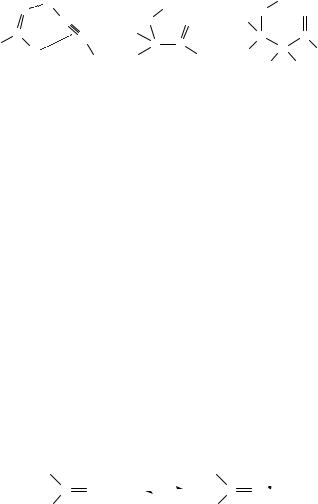
400 |
Luciano Forlani |
The acid catalysis (by protons) of carbonyl reactivity has been well known for a long time171 and the hydrogen bonding interactions, both intermolecular and intramolecular, are of interest also in explaining the chemical behaviour of carbonyl compounds. Investigation (by pulsed-nozzle FT microwave spectroscopy) of interactions between formaldehyde and acetylene172 (and five isotopomers) shows two main interactions, as illustrated in 97 involving a hydrogen bond between the oxygen of the carbonyl group and an acetylene proton, and another hydrogen bond between the acetylene system and a formaldehyde proton.
|
a |
H |
|
|
|
|
|
H |
O |
H |
|
|
O |
|
|
|
|
|
|
|
O |
|
|
|
|
C |
|
R1 |
O |
|
O |
CH3 |
|
|
|
|
C |
|
C |
|
|
|
C |
C |
|
||
H |
|
|
|
C |
|
C |
|
||||
H |
b |
|
R2 |
|
R |
C |
CH3 |
||||
|
H |
|
|
CH3 |
H |
||||||
|
|
|
|
|
|
|
|
|
H |
|
|
|
|
° |
|
R |
1 |
= R |
2 |
= CH3 |
R = CH3 , H. |
|
|
|
a = 2.39 A |
|
|
|
|
||||||
|
|
° |
|
R |
1 |
|
|
2 |
|
|
|
|
b = 3.66 A |
|
|
= H, R = CH3 |
|
|
|
||||
|
(97) |
|
|
|
|
(98) |
|
(99) |
|
||
Intramolecular hydrogen bonding is important for determining the conformation of flexible molecules. A great variety of molecules, including simple models and complicated biological systems, were considered when investigating their geometrical properties in the solid state8, and also in solutions: the feeble internal interactions may be easily modified by weak interaction with solvents.
The effects of temperature and pressure173 (investigated by FT-IR spectroscopy), show that ˛-hydroxy ketones exhibit stronger internal hydrogen-bonding interactions than ˇ- hydroxy ketones because of their configuration174. Five-membered chelate rings 98 are more planar than six-membered chelated rings 99.
Photoreduction of ketones can occur by direct proton transfer or after the formation of a CT complex. Tertiary amines (triethylamine175 and 1,4-diazabicyclo[2,2,2]octane176) were used as donors; see Scheme 40.
The CT complexes are considered to evolve to excited CT complexes. In Scheme 40, an electron is transferred from the amine to the benzophenone (in the triplet state) forming the CT complex. A proton transfer produces an amine radical 100 and a benzhydrol radical 101.
An instance of photoreduction of ketones by complexation with alkylbenzenes177,178 (as electron donors) is shown in Scheme 41. Products shown in Scheme 41 have been formed by radical coupling reactions. The investigations (using a combination of flash kinetics, steady-state quenching and quantum yield measurements) of the substituents and isotope (H/D) effect indicate that ketones react predominantly through CT complexes.
CT complexes between carbonyl groups and iodine (equilibrium 16) have been well known for a long time179, as well as complexes with bromine180.
R1 |
|
R1 |
|
|
C O + I2 |
K |
I2 |
(16) |
|
|
C O |
|||
|
||||
|
||||
R2 |
|
R2 |
|
|
Comparison of K values181,182 (obtained by the spectrophotometric method) allows evaluation of the electronic and steric effect of substituents R1 and R2 of equilibrium 16, for various carbonyl derivatives (ketones, aldehydes and derivatives of carboxylic acids).

8. Complex formation involving double-bonded functional groups |
401 |
||||||||||||||||||
|
|
|
|
|
|
|
|
|
|
|
|
Et |
|
|
|
||||
|
|
|
|
|
|
|
|
|
|
|
|
|
|
|
|||||
Ph |
|
|
|
Ph |
|
|
|
+ |
|
|
|
|
|||||||
C O + CH3 CH2 NEt2 |
|
|
|
|
|
|
|
|
|
− |
|
N |
|
|
Et |
|
|||
|
|
|
|
|
|
|
|
|
|
|
|||||||||
|
|
|
|
|
|
|
|
C |
O |
|
|
|
|
|
|
|
|
|
|
|
|
|
|
|
|
|
|
|
|
|
|
|
|
|
|
||||
CH3 |
|
|
CH3 |
H |
|
C |
|
|
H |
|
|||||||||
|
|
|
|
||||||||||||||||
|
|
|
|
|
|
|
|
|
|
||||||||||
|
|
|
|
|
|
|
|
|
|
|
|
|
|
|
|
|
|
|
|
|
|
|
|
|
|
|
|
|
|
|
Me |
|
|
|
|||||
|
|
|
|
|
|
|
|
|
CT complex |
|
|
|
|
|
|
|
|
|
|
|
|
|
|
|
|
|
|
|
|
|
|
|
|
|
|
|
|
||
Et |
|
|
|
|
|
|
|
|
|
|
|
|
|
|
|||||
|
|
|
|
|
|
|
|
|
|
|
|
|
|
|
|
|
|
||
N |
|
|
Et |
|
Ph |
|
|
|
|
|
|
|
|
|
|
||||
|
|
|
|
|
|
|
|
|
|
|
|
|
|||||||
|
|
|
|
|
|
|
|
|
|
|
|
|
|
|
|
|
|
|
|
C |
|
|
H + |
|
C |
OH |
|
|
|
|
|
|
|
|
|
||||
|
|
|
|
|
|
|
|
|
|
|
|||||||||
|
|
|
|
|
|
|
|
|
|
|
|
|
|
|
|
|
|
||
|
|
|
|
|
|
|
|
CH3 |
|
|
|
|
|
|
|
|
|
|
|
Me |
|
|
|
|
|
|
|
|
|
|
|
|
|
||||||
(100)(101)
|
|
|
SCHEME 40 |
|
|
|
CH3 |
δ − |
CH3 |
|
O |
|
O |
|
|
|
|
|
|
|
C |
+ |
Ph C |
|
|
|
|
δ+ |
|
Ph |
|
R |
|
|
|
R |
|
||
|
|
|
|
R= CF3 , Me, Ph
 CH2
CH2
OH
products |
|
Ph |
|
|
|
+ |
|
C |
|||||
|
|
|||||
R
SCHEME 41
Molecular complexes of substituted quinones are electron-acceptor molecules and their reactions with donor molecules have been extensively studied15.
Some bridgehead amines [1,4-diazabicyclo-[2,2,2]octane (102), quinuclidine (103) and quinuclidine-3-ol] form 1:1 molecular complexes with quinones 104. Formation of 2:1 (amine/quinone) complexes was observed in solutions of DABCO (102) and chloranil (104, R D Cl). These tertiary amines are able to form complexes, while non-bridgehead amines (triethylamine, piperidine) cannot because of steric hindrance or nitrogen inversion183. Stable complexes may be predicted (by CNDO/2 calculations) for

402 |
Luciano Forlani |
the approach of the amine lone pair perpendicular to the quinone plane at four middle points of the bond between the CDO group and C in ˛ position to the carbonyl group.
|
|
|
O |
N |
N |
R |
R |
|
|
||
|
|
|
R = Me, F, Cl |
N |
|
R |
R |
|
|
|
O |
(102) |
(103) |
|
(104) |
The oxidation of silyl enol ethers184 (105) to enone (107) by 2,3-dichloro-5,6-dicyano- 1,4-benzoquinone (106) is illustrated in Scheme 42. The electron donor acceptor complex (red, max D 520 nm) precedes the formation of the adduct 109, which is unreactive, and 108, which is the intermediate of the reaction. At 22 °C, the reaction mixture affords a mixture of 108 and of 109. At 100 °C, 108 is transformed into the final enone 107.
OTMS |
O |
|
|
|
NC |
|
Cl |
|
|
+ |
|
|
|
|
NC |
|
Cl |
|
|
|
O |
OTMS |
−O |
|
(105) |
(106) |
|
||
NC |
Cl |
|||
TMS=triemethylsilyl |
||||
+ |
|
|||
|
|
|
||
|
|
CT complex |
|
|
|
|
NC |
Cl |
|
|
|
|
||
|
|
|
O |
|
|
|
radical ion pair |
||
O |
OTMS |
|
|
OTMS |
NC |
Cl |
NC |
|
Cl |
+ |
|
O |
|
|
NC |
Cl |
|
NC |
Cl |
|
|
|
|
|
|
OH |
|
|
O |
(107)(108)
SCHEME 42
The mechanism of Scheme 42 is an alternative pathway to the hydride abstraction pathway of oxidation of trialkylsilyl enol ethers185. The silyl derivatives of 4-aza-3-ketosteroids
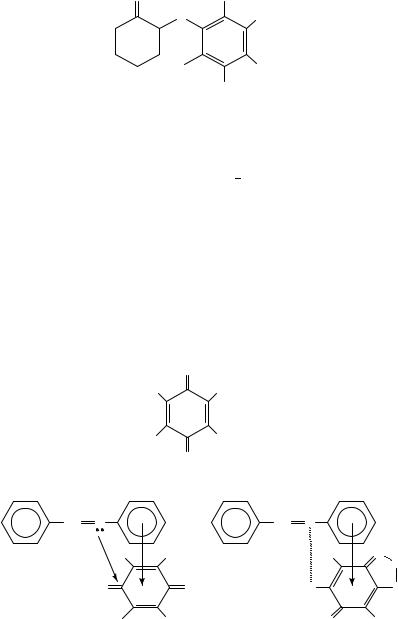
8. Complex formation involving double-bonded functional groups |
403 |
|
O |
CN |
|
O |
CN |
|
Cl |
OTMS |
|
|
Cl |
|
|
(109) |
|
are oxidized by 2,3-dichloro-5,6-dicyano-1,4-benzoquinone (106) via a CT complex and a substrate adduct186.
V. IMINO GROUP. ELECTRON DONOR ACCEPTOR COMPLEXES
While the role of many donor molecules in forming molecular complexes, in particular CT complexes15, has been often investigated, less attention has been paid to donor molecules bearing the imino group (Schiff bases).
Substituted benzylideneanilines form molecular complexes187 with 106 and with 2,5- dichloro-3,6-dihydroxy-p-benzoquinone (110) (chloranilic acid). These complexes were investigated by IR and 1H NMR. The complexes between benzylideneanilines and 106 are CT complexes (111), while complexes with 110 are formed through electron and proton transfer187, as illustrated in 112. In 111, ‘a’ refers to n ! Ł interaction and ‘b’ is a ! Ł interaction. sp2 N-atoms of some heterocyclic imines (such as 2,20 - bipyridyl, 1,10-phenantroline) are also n-donors towards acceptors (tetracyanoethylene, p-benzoquinone, chloranil)188.
|
|
O |
|
|
|
HO |
|
Cl |
|
|
Cl |
|
OH |
|
|
|
O |
|
|
|
|
(110) |
|
|
CH N |
|
|
H |
|
|
|
CH +N |
|
|
a CN |
b |
CN |
CN |
O |
|
|
|
H |
|
|
|
|
|
|
O |
|
O |
_O |
O |
Cl |
|
Cl |
O |
Cl |
|
(111) |
|
|
(112) |
Substituted imines 113 form CT complexes with substituted p-benzoquinones 114189 that show appreciable stability in the absence of oxygen (equilibrium 17). In some cases
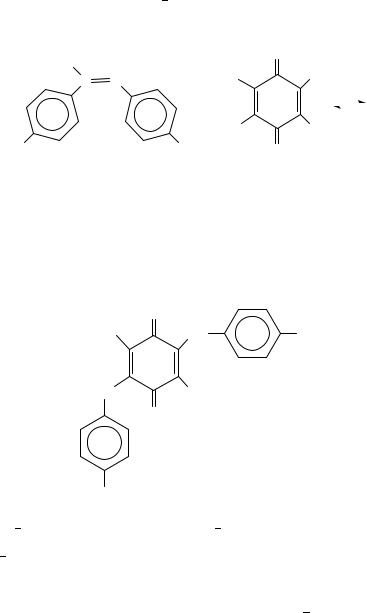
404 |
Luciano Forlani |
K values are obtained by the Benesi Hildebrand method15, and they are in the range from 0.8 to 2.5 dm3 mol 1. Electron-donating groups (R) in 113 enhance the K value according to the electron-donor character of 113.
H |
|
O |
|
|
|
|
R2 |
|
|||
C N |
R1 |
CT |
|||
|
+ |
|
|
K |
|
|
|
|
|
|
|
|
R2 |
R |
2 |
|
|
|
|
|
|||
|
|
|
|
|
|
Me2 N |
R |
O |
|
|
(17) |
(113) |
|
(114) |
|
|
|
R = H, Me, Br, Cl, OMe, NO. |
R1 |
= R2 = Br, |
|
||
|
R1 = R2 = Cl, |
|
|||
|
R1 |
= Cl, R2 |
= CN. |
|
|
The complexation of imines 113 favours their hydrolysis, with the formation of substituted anilines which form the products189 115 of the substitution of p-benzoquinone 114.
|
O |
|
R1 |
NH |
R |
HN |
R2 |
|
|
O |
|
R
(115)
Donor acceptor complexes are formed (by interaction) between arylhydrazones and trinitrofluorenes190, chloranil and tetracyanoethylene191. ESR investigation of donor acceptor mixtures in DMSO and in acetonitrile reveals the presence of a small degree of charge transfer.
Nitrones (116 and 117) form CT complexes192 with acceptors (tetracyanoethylene, p-benzoquinones). In these 1:1 complexes the stability is moderate; the stability constants were obtained using UV/VIS and they are in the range 0.03 0.15 dm3 mol 1. The presence of two phenyl groups in 116 enhances the stability of the complexes.
The CDN group of imines may react with nucleophiles at the carbon atom, or they may react at the nitrogen atom with electrophiles, including protons, as illustrated in 118.
In principle, the sp2 nitrogen atom of the CDN double bond of N-substituted imines (or of imidines) is a better nucleophile (and a better base193) than the sp3 nitrogen atom
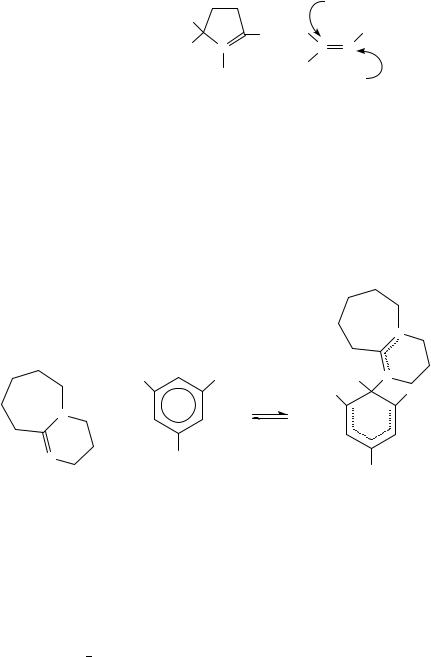
|
8. Complex formation involving double-bonded functional groups |
405 |
|||||||||
|
|
|
|
|
|
|
|
|
|
nucleophiles |
|
|
|
|
+ |
|
|
Me |
|
|
|
||
|
|
|
|
R1 |
|
|
|
|
|||
R |
|
C |
|
N |
|
Me |
+ |
Ph |
|
||
|
|
|
|
||||||||
|
|
|
|||||||||
|
|
|
|
||||||||
|
|
|
|
|
|
|
|
N |
C N |
|
|
|
|
|
_O |
|
_O |
|
|
||||
|
|
|
|
|
|
|
|
|
|
|
|
|
|
|
|
|
|
|
|
|
|
electrophiles |
|
(116) |
|
|
|
(117) |
(118) |
|
|||||
R = R1 |
= Me |
|
|
|
|
||||||
R = Ph, R1 = Me |
|
|
|
|
|||||||
R = Ph, R1 = CMe3 |
|
|
|
|
|||||||
R = R1 |
= Ph |
|
|
|
|
||||||
of tertiary amines. A possible explanation is that the steric hindrance in tertiary amines depresses the nucleophilic power of the nitrogen194.
If the H2N CDNH system is considered as a bident nucleophile, internal conjugation strongly increases the nucleophilic ability of the CDNH nitrogen and depresses the nucleophilic ability of the NH2 group195.
|
|
|
|
N |
|
|
|
|
+ |
|
O2 N |
NO2 |
H |
N |
|
|
O2 N |
|
NO2 |
N |
+ |
|
|
− |
|
|
|
||
|
|
|
|
|
N |
|
NO2 |
|
|
DBU |
|
TNB |
|
NO2 |
|
|
|
||
|
|
|
|
(119) |
|
|
SCHEME 43 |
|
|
1,8-Diazabicyclo[5,4,0]undec-7-ene (DBU) reacts with 1,3,5-trinitrobenzene (TNB) to yield a zwitterionic complex (119)196 as shown by Scheme 43. The delocalization of the positive charge, as well as the delocalization of the negative charge, are factors stabilizing the zwitterionic complex (119). The presence of another sp3 nitrogen atom conjugated with the CDN double bond of amidines favours (by an electronic effect) the nucleophilic power of the sp2 nitrogen. In strongly associating solvents (toluene) the formation of the-complex (119) is preceded by a quickly established equilibrium that forms a molecular complex between DBU and TNB, as shown in equilibrium 18, where the interaction is mainly a donor acceptor interaction197. The K value decreases as the temperature increases [K D 7.3, 4.9 and 3.1 (mol 1 dm3) at 25, 35 and 45 °C, respectively] as required by an associative process197. The presence of the molecular complex on the reaction
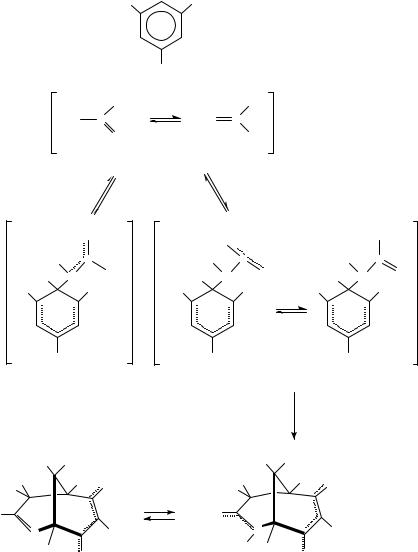
406 |
Luciano Forlani |
pathway of the formation of the complex 119 (and of nucleophilic aromatic substitution reactions in poorly polar solvents when amines are used as nucleophiles) explains the negative dependence of observed rates of substitution reactions on the temperature197.
|
|
|
K |
|
TNB |
C |
DBU ! MOLECULAR COMPLEX |
18 |
|
|
|
|
|
|
|
|
O2 N |
NO2 |
|
|
|
NO2 |
|
|
|
+ |
|
|
NR1 |
NR2 |
R = H, R1 = Me |
|
2 |
|
|
RCH2 |
C |
RCH C |
R = R1 = Me |
|
NH |
NH2 |
R = Ph, R1 = Me |
|
|
(120) |
|
|
|
NR12 |
|
1 |
|
|
|
NR21 |
|
|
|
|
NR2 |
+ |
|
|
|
H |
|
+ C |
R |
|
R |
|
C |
|
|
|
C |
|
|||||
H |
N |
CH2 R |
H |
CH |
NH2 |
H |
CH |
NH |
|
|
|
||||||
O2 N |
|
NO2 |
O2 N |
|
NO2 |
O2 N |
|
NO2 |
|
|
|
|
|
|
−H + |
|
|
− |
|
|
− |
|
|
− |
|
|
NO2 |
|
NO2 |
|
NO2 |
|
|||
(121) |
|
|
|
|
|
(122) |
|
|
H |
NO2 |
|
|
|
H |
NO2 |
|
H |
H |
NO2 |
|
H |
|
H |
NO2 |
R |
|
|
R |
|
|
||
R12 N |
− |
−H+ |
1 |
|
− |
|
|
|
R |
2 N |
|
|
|||
N |
|
H |
|
+ |
N |
|
H |
H |
NO2 |
|
|
H |
H |
NO2 |
|
|
|
|
|
|
|
||
|
|
(123) |
|
|
|
|
|
SCHEME 44
